Where She Blows! A Ten Year Dust Climatology of Western New South Wales Australia
Abstract
:1. Introduction
- Where are the dusty places?
- What are the trends in dust activity?
- What thresholds of annual dust hours should we be striving to be below?
2. Materials and Methods
2.1. Dust Data
- Factory calibration is undertaken annually by the Australian distributor adjusted to respirable mass standard ISO 12103-1 Al Test Dust Arizona Dust. Calibration for a particular source material is not warranted as the network covers many sites across southern Australia with multiple dust source types.
- Instruments are calibrated on site each month to have a zero (clean air) reading of ±3 µg/m3. Inlets are cleaned and water bottles are emptied.
- Every 15 min a zero reading is taken through the manufacturers ‘zero filter’ and stored in the database. This value is then subtracted from all of the ambient readings until the next zero filter reading is taken. This overcomes the problem of temperature variations or instrument drift.
- All data are held within a purpose built supervisory control and data acquisition (SCADA) application called CoDii.
- Each hourly reading is quality checked. CoDii downloads the data hourly and calculates the hourly time averaged aerosol concentration.
- Values below 10 μg/m3 are not quality assessed because the DustWatch project is interested in higher concentrations for the detection of dust events.
- Meteorological data from the nearest Australian Bureau of Meteorology automatic weather station and NASA MODIS Rapidfire data (http://lance-modis.eosdis.nasa.gov/imagery/subsets/?project=other) are used to ascribe the hourly reading as dust, smoke, or fog using the following rules:
- If values are above 10 μg/m3—flag as dust unless following criteria are met. Note: While the manufacturer suggests instrument accuracy is about 3 µg/m3, we choose to be conservative and do not use values less than 10 µg/m3.
- Flag as fog if:
- humidity is high (>80%) and wind speed is low (<20 km/h); and,
- observers report fog at that time.
- Flag as smoke if:
- wind speeds are less than 20 km/h within ± 3 h of reading;
- fires and/or smoke are reported by observers within the area or the smoke plume visible on MODIS images; and,
- values spike early morning and late afternoon in cooler months and wind speed is low (<20 km/h) as this is likely to be smoke from wood heaters in populated areas.
- Flag as malfunction if:
- dust values are below 0;
- dust values are erratic or extremely high without obvious reason;
- the DustTrak displays an error message; and,
- local knowledge suggests a malfunction.
2.2. Rainfall and Ground Cover Data
3. Results
3.1. Dusty Places
3.2. Trends
3.3. Dust Targets
4. Discussion
5. Conclusions
- Where are the dusty places? Not surprisingly, Tibooburra is the dustiest place in NSW. This is a function of its low rainfall and location down-wind of the Lake Eyre Basin. The data also indicates that semi-arid dryland farming areas, like Euston and Pooncarie, are dusty. Once again, not surprising considering the low rainfall and the risks of semi-arid dryland farming.
- What are the trends in dust activity? The trend over the last decade in NSW has been downwards; however, this is a function of rainfall. Within the rainfall dust relationship, are other factors, like land use (farming), erodibility of the landscape (sandy soil areas have higher erosion), and perenniality of the vegetation (treed areas tend to have less dust).
- What levels of dust should we be aiming for? This data set has enabled us to set DSY dust hour targets for NSW based on the DSY rainfall. Basically, there is a 10 h drop in the dust target for every 100 mm increase in DSY rainfall between 250 and 650 mm. These targets are guides as to what dust activity might be expected across western NSW. They can be used to investigate the performance of the land management systems and to report the state of the environment of NSW.
Author Contributions
Funding
Acknowledgments
Conflicts of Interest
References
- Middleton, N.J.; Goudie, A.S. Saharah dust: Sources and trajectories. Trans. Inst. Br. Geogr. 2001, 26, 165–181. [Google Scholar] [CrossRef]
- Cattle, S.R. The case for a southeastern Australian Dust Bowl, 1895–1945. Aeolian Res. 2016, 21, 1–20. [Google Scholar] [CrossRef]
- Leys, J.; Smith, J.; MacRae, C.; Rickards, J.; Yang, X.; Randall, L.; Hairsine, P.; Dixon, J.; McTainsh, G. Improving the Capacity to Monitor Wind and Water Erosion: A Review; Department of Agriculture, Fisheries and Forests, Australian Government: Canberra, Australia, 2009; p. 160.
- Webb, N.P.; Van Zee, J.W.; Karl, J.W.; Herrick, J.E.; Courtright, E.M.; Billings, B.J.; Boyd, R.; Chappell, A.; Duniway, M.C.; Derner, J.D.; et al. Enhancing Wind Erosion Monitoring and Assessment for U.S. Rangelands. Rangelands 2017, 39, 85–96. [Google Scholar] [CrossRef]
- Australian Government. National Landcare Programme. Available online: http://www.nrm.gov.au/national-landcare-programme (accessed on 30 August 2017).
- Australian Government Department of Environment and Heritage. Australia State of the Environment 2006: At a Glance; Australian Government Department of Environment and Heritage: Canberra, Australia, 2006; p. 16.
- Metcalfe, D.J.; Bui, E.N. Australia State of the Environment 2016: Land, Independent Report to the Australian Government Minister for the Environment and Energy; Australian Government Department of the Environment and Energy: Canberra, Australia, 2017.
- European Environment Agency. The European Environment—State and Outlook: Synthesis Report; European Environment Agency: Copenhagen, Denmark, 2015; p. 205.
- United States Environmental Protection Agency. Report on the Environment; National Center for Environmental Assessment: Washington, DC, USA, 2008; p. 366.
- Webb, N.P.; Herrick, J.E.; Van Zee, J.W.; Courtright, E.M.; Hugenholtz, C.H.; Zobeck, T.M.; Okin, G.S.; Barchyn, T.E.; Billings, B.J.; Boyd, R.; et al. The National Wind Erosion Research Network: Building a standardized long-term data resource for aeolian research, modeling and land management. Aeolian Res. 2016, 22, 23–36. [Google Scholar] [CrossRef] [Green Version]
- Leys, J.; Heidenreich, S.; Koen, T.; Colson, I. DustWatch Network and Roadside Survey 2016; Report for Contract WN00732; NSW Government, Local Land Services: Dubbo, Australia, 2016; p. 27.
- Strong, C.L.; Parsons, K.; McTainsh, G.H.; Sheehan, A. Dust transporting wind systems in the lower Lake Eyre Basin, Australia: A preliminary study. Aeolian Res. 2011, 2, 205–214. [Google Scholar] [CrossRef]
- He, Y.; Zhao, C.; Song, M.; Liu, W.; Chen, F.; Zhang, D.; Liu, Z. Onset of frequent dust storms in northern China at ~AD 1100. Sci. Rep. 2015, 5, 17111. [Google Scholar] [CrossRef] [PubMed] [Green Version]
- Toney, J.L.; Anderson, R.S. A postglacial palaeoecological record from the San Juan Mountains of Colorado USA. Holocene 2006, 16, 505–517. [Google Scholar] [CrossRef]
- McConnell, J.R.; Aristarain, A.J.; Banta, J.R.; Edwards, P.R.; Simões, J.C. 20th-Century doubling in dust archived in an Antarctic Peninsula ice core parallels climate change and desertification in South America. Proc. Natl. Acad. Sci. USA 2007, 104, 5743–5748. [Google Scholar] [CrossRef] [PubMed] [Green Version]
- Mulitza, S.; Heslop, D.; Pittauerova, D.; Fischer, H.W.; Meyer, I.; Stuut, J.-B.; Zabel, M.; Mollenhauer, G.; Collins, J.A.; Kuhnert, H.; et al. Increase in African dust flux at the onset of commercial agriculture in the Sahel region. Nature 2010, 166, 226–228. [Google Scholar] [CrossRef] [PubMed]
- Tanaka, T.Y.; Chiba, M. A numerical study of the contributions of dust source regions to the global dust budget. Glob. Planet. Chang. 2006, 52, 88–104. [Google Scholar] [CrossRef]
- Astitha, M.; Lelieveld, J.; Abdel Kader, M.; Pozzer, A.; de Meij, A. Parameterization of dust emissions in the global atmospheric chemistry-climate model EMAC: Impact of nudging and soil properties. Atmos. Chem. Phys. 2012, 12, 11057–11083. [Google Scholar] [CrossRef]
- Olson, J.S. World Ecosystems (WE1.4). Digital Raster Data on a 10-Minute Cartesian Orthonormal Geodetic 1080 × 2160 Grid. Available online: http://ref.data.fao.org/map?entryId=be34dd90-88fd-11da-a88f-000d939bc5d8&tab=about (accessed on 6 May 2018).
- Prospero, J.M.; Ginoux, P.; Torres, O.; Nicholsan, S.E.; Gill, T. Environmental characterisation of global sources of atmospheric soil dust identified with the NIMBUS-7 total ozone mapping spectrometer (TOMS) absorbing aerosol product. Rev. Geophys. 2002, 40, 2-1–2-31. [Google Scholar] [CrossRef]
- Washington, R.; Todd, M.; Middleton, N.J.; Goudie, A.S. Dust-storm source areas determined by the Total Ozone Monitoring Spectrometer and surface observations. Ann. Assoc. Am. Geogr. 2003, 93, 297–313. [Google Scholar] [CrossRef]
- Varga, G. Spatio-temporal distribution of dust storms—A global coverage using NASA TOMS aerosol measurements. Hung. Geogr. Bull. 2012, 61, 275–298. [Google Scholar]
- Baddock, M.; Bullard, J.; McTainsh, G.H.; Leys, J.F. Linking Geomorphology and Dust Emission: Identifying Dust Sources at the Sub-Basin Scale, Lake Eyre Basin Australia; British Geomorphological Research Group (BGRG) Workshop, “Another Windy Day at Northampton”, University of Northampton; British Geomorphological Research Group, University of Northampton: Northampton, UK, 2007. [Google Scholar]
- Baddock, M.C.; Bullard, J.E.; Bryant, R.G. Dust source identification using MODIS: A comparison of techniques applied to the Lake Eyre Basin, Australia. Remote Sens. Environ. 2009, 113, 1511–1528. [Google Scholar] [CrossRef] [Green Version]
- Raupach, M.R.; McTainsh, G.H.; Leys, J.F. Estimates of dust mass in recent major dust storms. Aust. J. Soil Water Conserv. 1994, 7, 20–24. [Google Scholar]
- McGowan, H.; Clark, A. A vertical profile of PM10 dust concentrations measured during a regional dust event identified by MODIS Terra, western Queensland, Australia. J. Geophys. Res. 2008, 113. [Google Scholar] [CrossRef] [Green Version]
- Ginoux, P.; Prospero, J.M.; Gill, T.E.; Hsu, N.C.; Zhao, M. Global-scale attribution of anthropogenic and natural dust sources and their emission rates based on MODIS Deep Blue aerosol products. Rev. Geophys. 2012, 50. [Google Scholar] [CrossRef] [Green Version]
- Chun, Y.; Cho, H.; Chung, H.; Lee, M. From Historical Records to Early Warning System of Asian dust (Hwangsa) in Korea. Bull. Am. Meteorol. Soc. 2008, 86, 823–827. [Google Scholar] [CrossRef]
- Lee, J.A.; Wigner, K.A.; Gregory, J.M. Drought, Wind and Blowing Dust on the Southern High Plains of the United States. Phys. Geogr. 1993, 14, 56–67. [Google Scholar]
- Middleton, N.J. Dust storms in Australia: Frequency, distribution and seasonality. Search 1984, 15, 46–47. [Google Scholar]
- Middleton, N.J. Dust storms in the Middle East. J. Arid Environ. 1984, 10, 83–96. [Google Scholar]
- Middleton, N.J. A geography of dust storms in South-West Asia. J. Climatol. 1986, 6, 183–196. [Google Scholar] [CrossRef]
- McTainsh, G.; Strong, C.; Leys, J.; Baker, M.; Tews, K.; Barton, K. Wind Erosion Histories, Model Input Data and Community DustWatch; Atmospheric Environment Research Centre, Griffith University: Brisbane, Australia, 2009; p. 221. [Google Scholar]
- O’Loingsigh, T.; McTainsh, G.H.; Parsons, K.; Strong, C.L.; Shinkfield, P.; Tapper, N.J. Using meteorological observer data to compare wind erosion during two great droughts in eastern Australia; the World War II Drought (1937–1946) and the Millennium Drought (2001–2010). Earth Surf. Process. Landf. 2015, 40, 123–130. [Google Scholar] [CrossRef]
- Goudie, A.S.; Middleton, N.J. The changing frequency of dust storms through time. Clim. Chang. 1992, 20, 197–225. [Google Scholar] [CrossRef]
- O’Loingsigh, T.; Chubb, T.; Baddock, M.; Kelly, T.; Tapper, N.J.; De Deckker, P.; McTainsh, G. Sources and pathways of dust during the Australian “Millennium Drought” decade. J. Geophys. Res. 2017, 122, 1246–1260. [Google Scholar] [CrossRef]
- Leys, J.F.; McTainsh, G.H.; Strong, C.L.; Heidenreich, S.; Biesaga, K. DustWatch: Using community networks to improve wind erosion monitoring in Australia. Earth Surf. Process. Landf. 2008, 33, 1912–1926. [Google Scholar] [CrossRef]
- Bullard, J.; Baddock, M.; McTainsh, G.; Leys, J. Sub-basin scale dust source geomorphology detected using MODIS. Geophys. Res. Lett. 2008, 35, L15404. [Google Scholar] [CrossRef]
- Nickling, W.G.; McTainsh, G.H.; Leys, J.F. Dust emissions from the Channel Country of western Queensland, Australia. Z. Geomorphol. Suppl. 1999, 116, 1–17. [Google Scholar]
- Sharratt, B.; Wendling, L.; Feng, G. Surface characteristics of a windblown soil altered by tillage intensity during summer fallow. Aeolian Res. 2012, 5, 1–7. [Google Scholar] [CrossRef]
- Alfaro, S.C.; Gomes, L. Modelling mineral aerosol production by wind erosion: Emission intensities and aerosol size distributions in source areas. J. Geophys. Res. 2001, 106, 18075–18084. [Google Scholar] [CrossRef]
- Baddock, M.C.; Strong, C.L.; Leys, J.F.; Heidenreich, S.K.; Tews, E.K.; McTainsh, G.H. A visibility and total suspended dust relationship. Atmos. Environ. 2014, 89, 329–336. [Google Scholar] [CrossRef] [Green Version]
- Guerschman, J.P.; Scarth, P.F.; McVicar, T.R.; Renzullo, L.J.; Malthus, T.J.; Stewart, J.B.; Rickards, J.E.; Trevithick, R. Assessing the effects of site heterogeneity and soil properties when unmixing photosynthetic vegetation, non-photosynthetic vegetation and bare soil fractions from Landsat and MODIS data. Remote Sens. Environ. 2015, 161, 12–26. [Google Scholar] [CrossRef]
- Leys, J.F. Wind erosion on agricultural land. In Aeolian Environments, Sediments and Landforms; Goudie, A.S., Livingston, I., Stokes, S., Eds.; John Wiley and Sons: Chinchester, UK, 1999; pp. 143–166. [Google Scholar]
- McTainsh, G.H.; Leys, J.F. Soil Erosion by Wind; Longman Cheshire: Melbourne, Australia, 1993; pp. 188–233. [Google Scholar]
- Koenker, R.; Hallock, K. Quantile regression: An introduction. J. Econ. Perspect. 2001, 15, 143–156. [Google Scholar] [CrossRef]
- Bureau of Meteorology. Annual Climate Summary. 2009. Available online: http://www.bom.gov.au/climate/annual_sum/2009/AnClimSum09_LR1.1.pdf (accessed on 22 April 2018).
- Bureau of Meteorology. Annual Climate Summary. 2010. Available online: http://www.bom.gov.au/climate/annual_sum/2010/AnClimSum10_HR1.0.pdf (accessed on 22 April 2018).
- Leys, J.F. The threshold friction velocities and soil flux rates of selected soils in south-west New South Wales, Australia. Acta Mech. 1991, 2, 103–112. [Google Scholar]
- Chepil, W.S. Factors that influence clod structure and erodibility by wind. I. Soil texture. Soil Sci. 1953, 75, 473–483. [Google Scholar] [CrossRef]
- McTainsh, G. Harmattan dust deposition in Northern Nigeria. Nature 1980, 286, 587–588. [Google Scholar] [CrossRef]
- Bullard, J.E.; McTainsh, G.H. Aeolian-fluvial interactions in dryland environments: Examples, concepts and Australian case study. Prog. Phys. Geogr. 2003, 27, 471–501. [Google Scholar] [CrossRef]
- Baddock, M.C.; Parsons, K.; Strong, C.L.; Leys, J.F.; McTainsh, G.H. Drivers of Australian dust: A case study of frontal winds and dust dynamics in the lower Lake Eyre Basin. Earth Surf. Process. Landf. 2015, 40, 1982–1988. [Google Scholar] [CrossRef] [Green Version]
- Tegen, I.; Fung, I. Contribution to the atmospheric mineral aerosol load from land surface modification. J. Geophys. Res. 1995, 100, 18707–18726. [Google Scholar] [CrossRef]
- DustWatch. DustWatch Report February 2013; Office of Environment and Heritage: Sydney, Australia, 2013; p. 4.
- DustWatch. DustWatch Report February 2014; Office of Environment and Heritage: Sydney, Australia, 2014; p. 4.
- DustWatch. DustWatch Report January 2014; Office of Environment and Heritage: Sydney, Australia, 2014; p. 3.
- DustWatch. DustWatch Report November 2014; Office of Environment and Heritage: Sydney, Australia, 2014; p. 6.
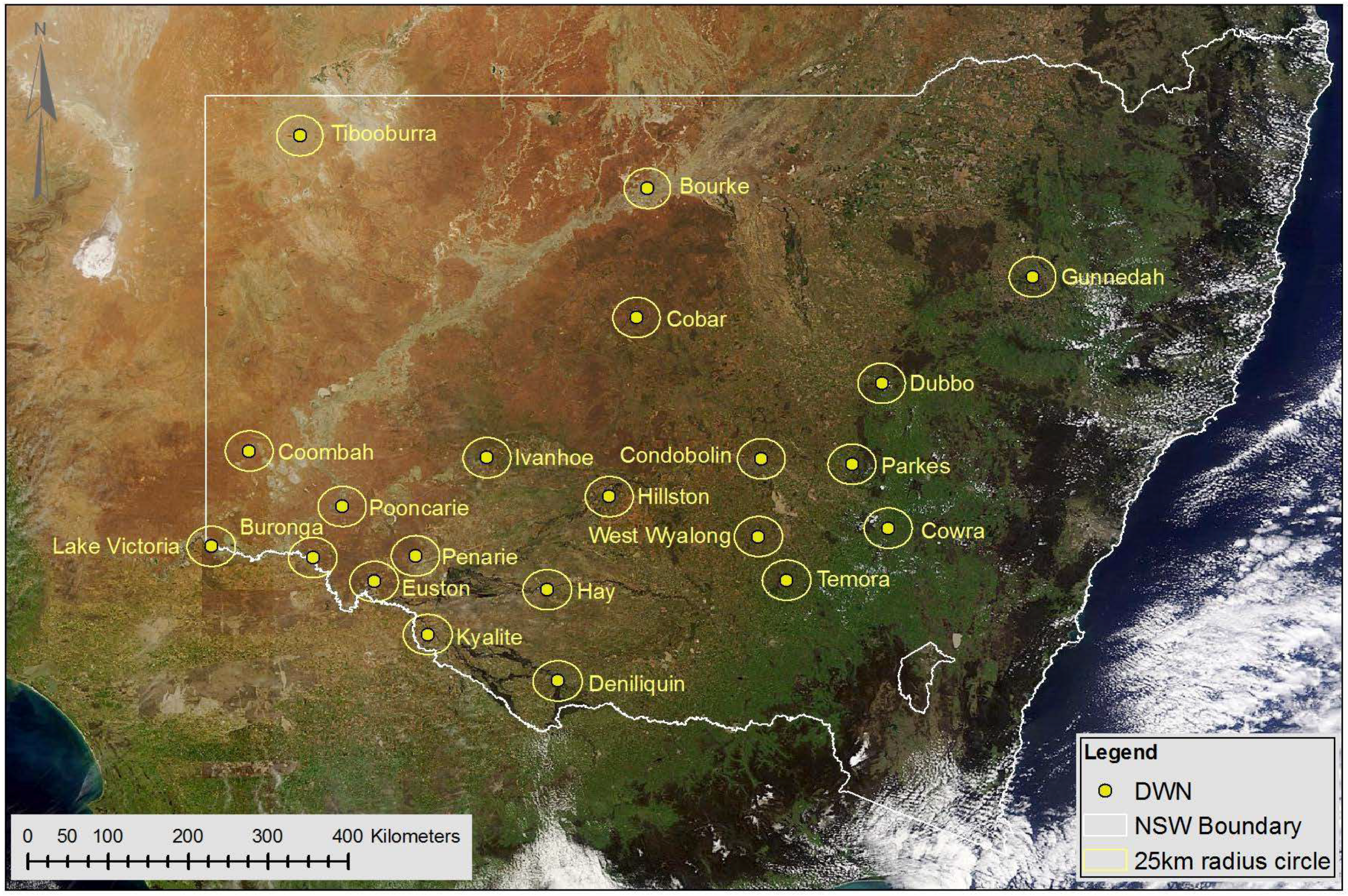
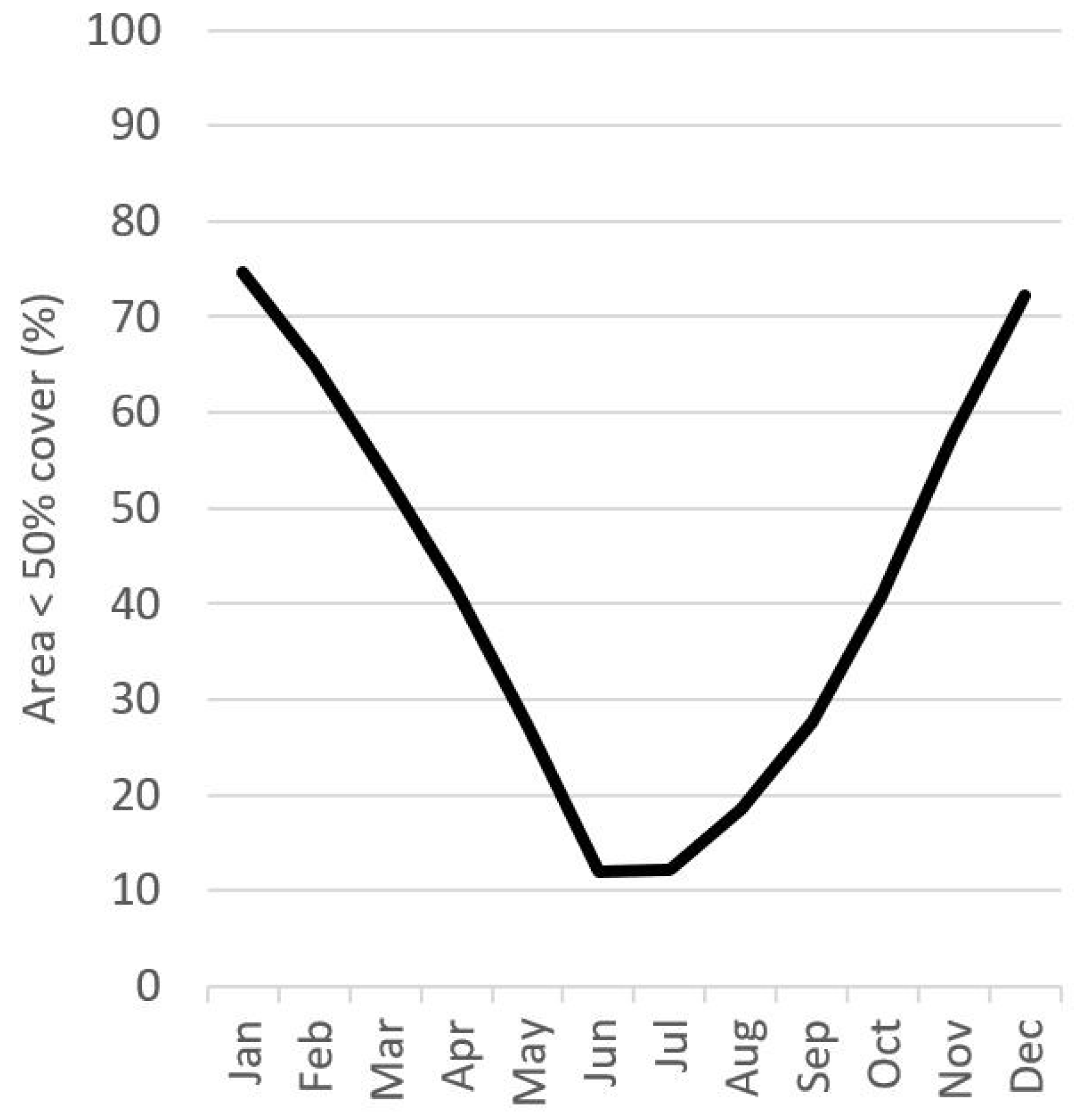
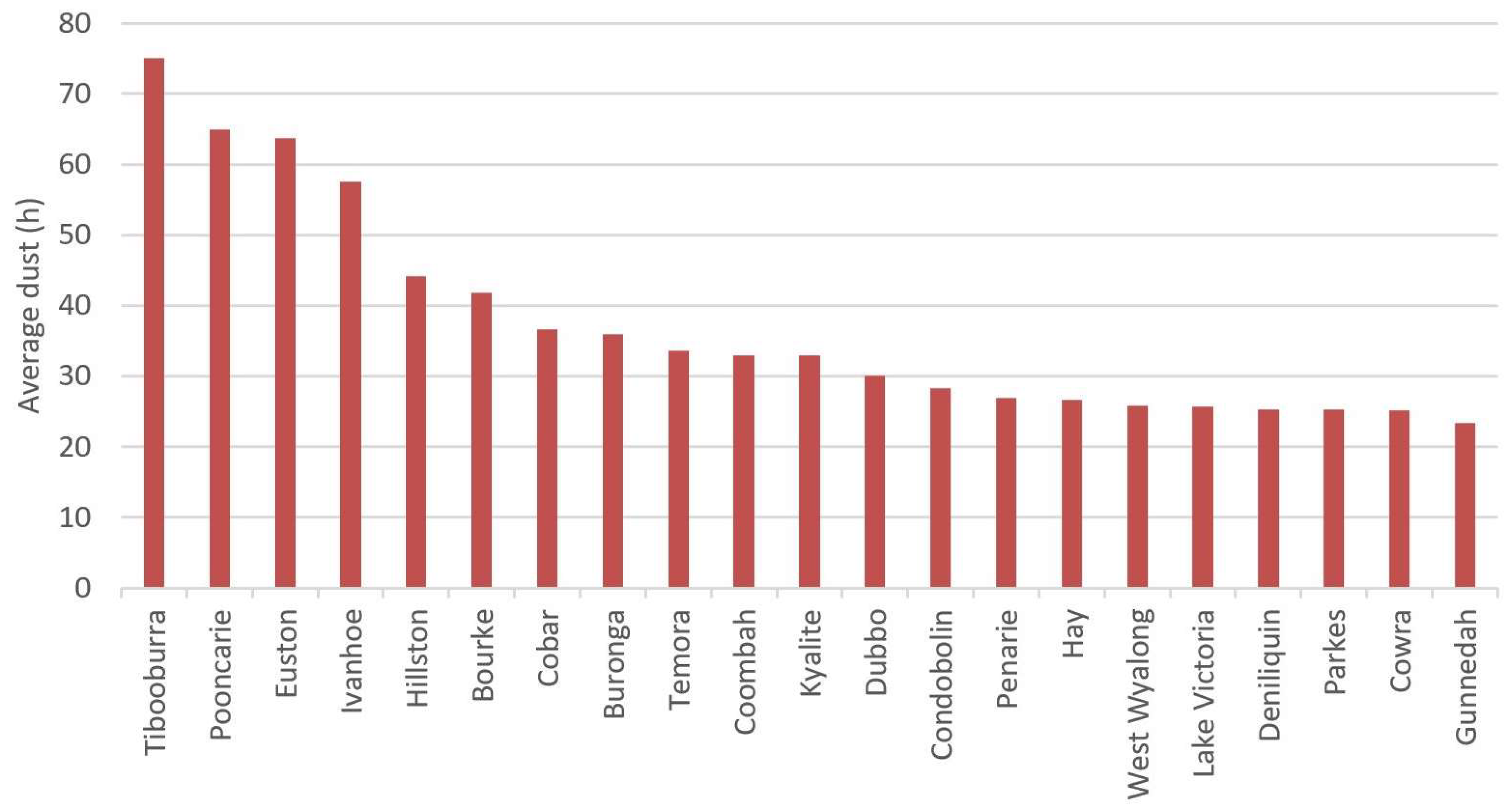

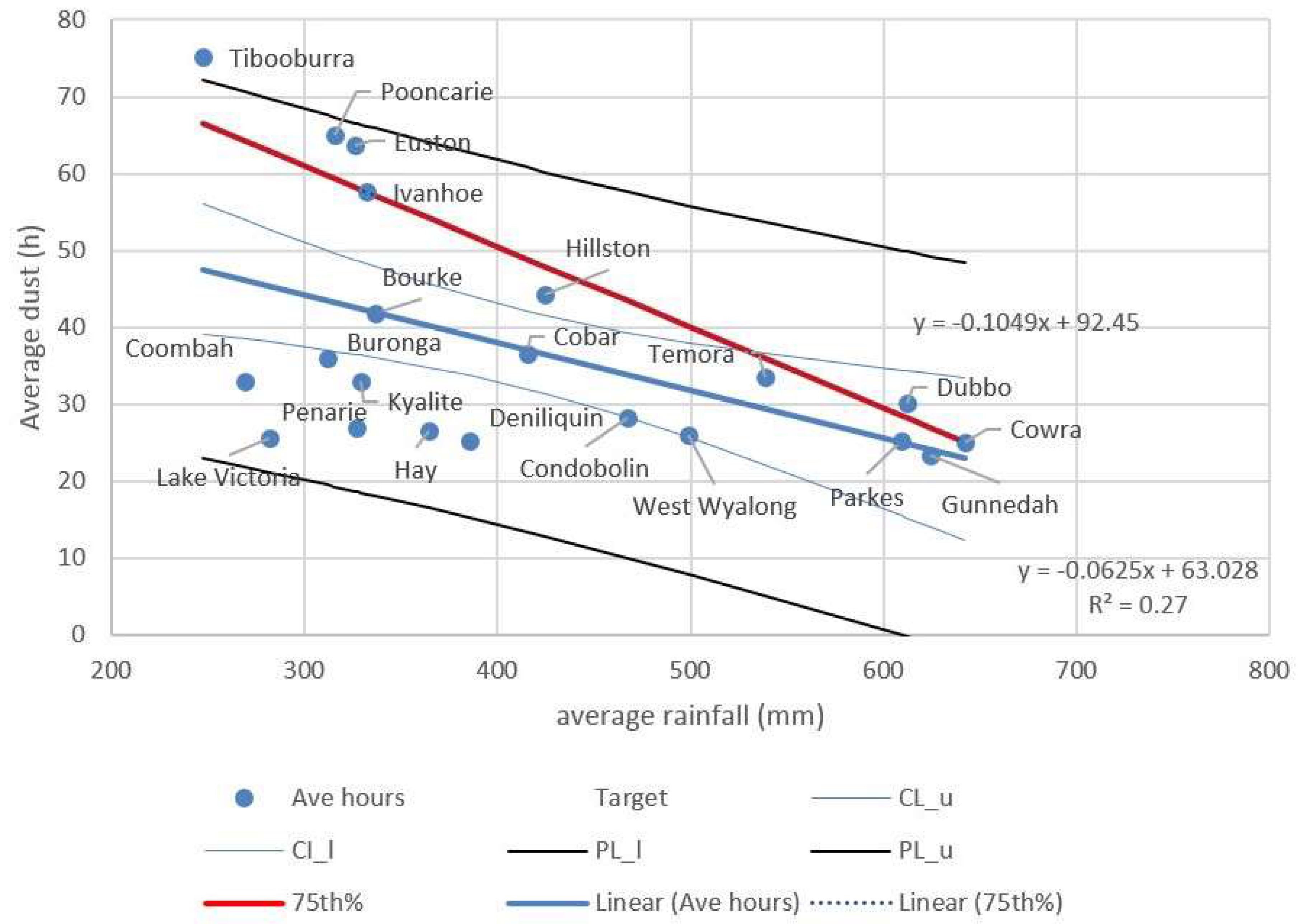
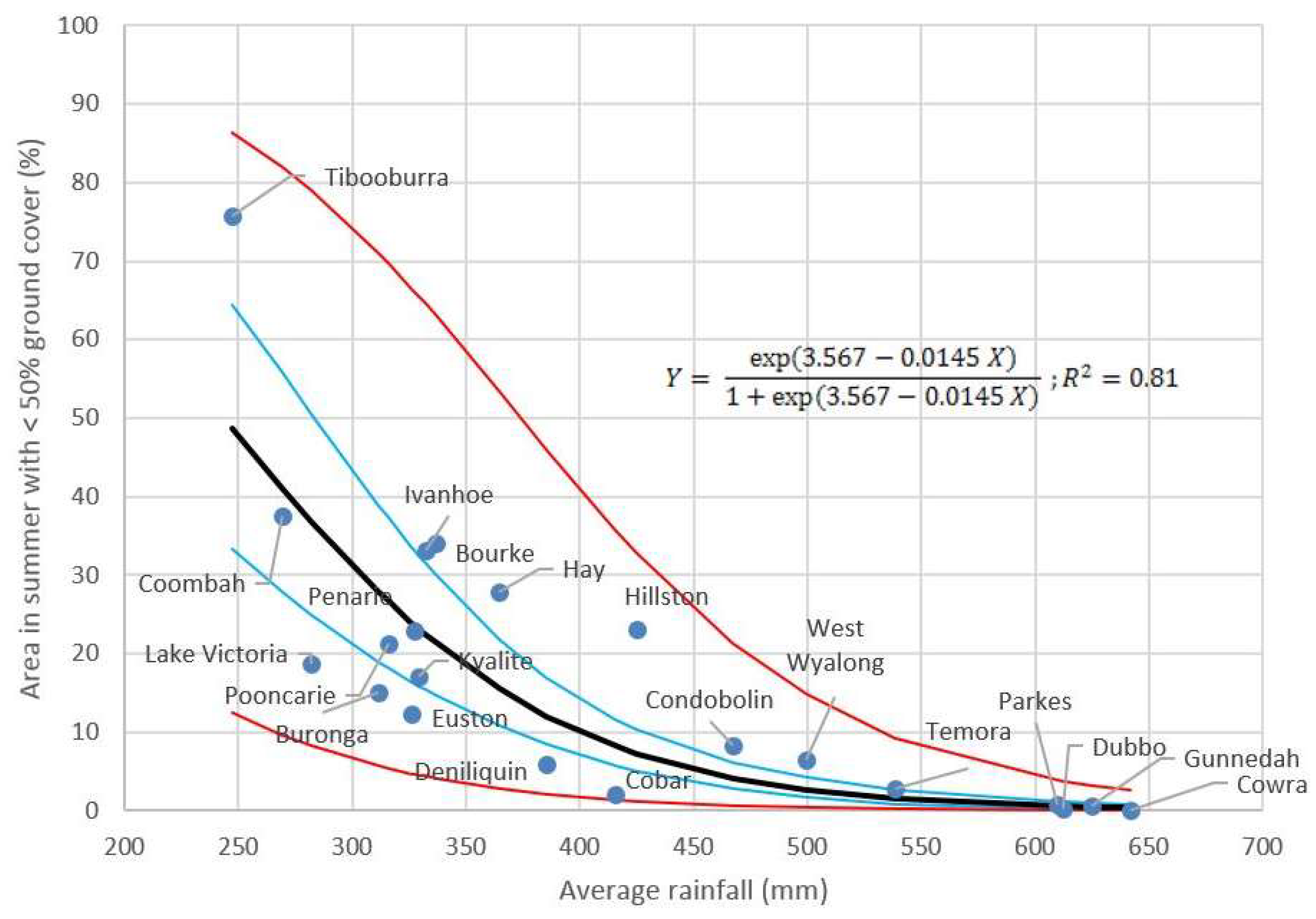

| DWN | 2007/08 | 2008/09 | 2009/10 | 2010/11 | 2011/12 | 2012/13 | 2013/14 | 2014/15 | 2015/16 | 2016/17 | Average | Target |
|---|---|---|---|---|---|---|---|---|---|---|---|---|
| Bourke | 86 | 49 | 201 | 2 | 22 | 13 | 23 | 19 | 0 | 4 | 42 | 57 |
| Buronga | 54 | 74 | 113 | 7 | 30 | 25 | 14 | 33 | 9 | 1 | 36 | 60 |
| Cobar | 85 | 77 | 128 | 5 | 13 | 16 | 12 | 23 | 1 | 6 | 37 | 49 |
| Condobolin | 95 | 77 | 50 | 3 | 4 | 9 | 16 | 19 | 9 | 1 | 28 | 43 |
| Coombah | 45 | 49 | 155 | 1 | 0 | 20 | 26 | 17 | 16 | 1 | 33 | 64 |
| Cowra | 44 | 43 | 135 | 0 | 1 | 5 | 1 | 14 | 1 | 7 | 25 | 25 |
| Deniliquin | 57 | 61 | 36 | 2 | 14 | 20 | 13 | 28 | 16 | 6 | 25 | 52 |
| Dubbo | 34 | 62 | 110 | 2 | 2 | 12 | 32 | 34 | 5 | 8 | 30 | 28 |
| Euston | 85 | 135 | 141 | 2 | 15 | 107 | 12 | 61 | 63 | 16 | 64 | 58 |
| Gunnedah | 52 | 19 | 113 | 1 | 0 | 5 | 17 | 12 | 14 | 1 | 23 | 27 |
| Hay | 47 | 84 | 61 | 1 | 1 | 10 | 16 | 29 | 11 | 6 | 27 | 54 |
| Hillston | 98 | 138 | 113 | 4 | 14 | 12 | 11 | 33 | 8 | 11 | 44 | 48 |
| Ivanhoe | 131 | 168 | 216 | 3 | 11 | 5 | 3 | 15 | 17 | 7 | 58 | 58 |
| Kyalite | 65 | 75 | 43 | 2 | 15 | 25 | 13 | 29 | 44 | 18 | 33 | 58 |
| Lake Victoria | 43 | 35 | 108 | 5 | 10 | 11 | 3 | 9 | 29 | 4 | 26 | 63 |
| Parkes | 77 | 46 | 95 | 2 | 2 | 10 | 0 | 15 | 3 | 3 | 25 | 29 |
| Penarie | 63 | 67 | 35 | 2 | 9 | 23 | 16 | 20 | 30 | 5 | 27 | 58 |
| Pooncarie | 210 | 195 | 143 | 6 | 3 | 12 | 18 | 39 | 10 | 14 | 65 | 59 |
| Temora | 113 | 82 | 85 | 10 | 4 | 2 | 4 | 22 | 8 | 6 | 34 | 36 |
| Tibooburra | 116 | 121 | 413 | 0 | 16 | 6 | 23 | 37 | 15 | 4 | 75 | 66 |
| West Wyalong | 75 | 47 | 82 | 3 | 4 | 18 | 4 | 18 | 3 | 5 | 26 | 40 |
© 2018 by the authors. Licensee MDPI, Basel, Switzerland. This article is an open access article distributed under the terms and conditions of the Creative Commons Attribution (CC BY) license (http://creativecommons.org/licenses/by/4.0/).
Share and Cite
Leys, J.; Strong, C.; Heidenreich, S.; Koen, T. Where She Blows! A Ten Year Dust Climatology of Western New South Wales Australia. Geosciences 2018, 8, 232. https://doi.org/10.3390/geosciences8070232
Leys J, Strong C, Heidenreich S, Koen T. Where She Blows! A Ten Year Dust Climatology of Western New South Wales Australia. Geosciences. 2018; 8(7):232. https://doi.org/10.3390/geosciences8070232
Chicago/Turabian StyleLeys, John, Craig Strong, Stephan Heidenreich, and Terry Koen. 2018. "Where She Blows! A Ten Year Dust Climatology of Western New South Wales Australia" Geosciences 8, no. 7: 232. https://doi.org/10.3390/geosciences8070232





